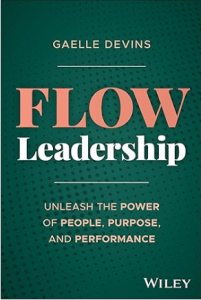By Gaelle Devins, above, Chief Customer Officer & Member of the Executive Board at Breitling, and author of Flow Leadership
Gallup’s State of the Global Workplace Report 2025, released earlier this year, made for concerning reading.
Amongst other findings, the research revealed that employee engagement globally has fallen for only the second time this year since records began. Notably, this shortfall is particularly pronounced amongst younger workers, and managers struggling to juggle rising workloads and the changing expectations of their teams.
With the leaders of both today and tomorrow less engaged at work than ever, change is urgently needed at the top level. We need a new style of leadership, that meets the needs of employees both now and in the future. Through this, we can reverse the toxic trend of disengaged, miserable and unfulfilled employees, and ensure that people remain the heart of any successful business.
Enter an emerging style of leadership, revolutionising teams from SMEs right up to world-leading corporations – Flow Leadership.
What is Flow Leadership?
Flow State, first developed by Mihaly Csikszentmihalyi in 1975, is an incredibly powerful state of mind. Often referred to as being “in the zone”, flow state is the complete absorption in what one does – where we experience life and work more intensely, feel amplified meaning in what we do and, through this, achieve results previously thought impossible.
By prioritising the well-being of their people, fostering a sense of shared purpose throughout the business, and promoting continual performance growth – balancing People, Purpose and Performance – SME leaders can cultivate a high-achieving culture wherein employees are productive, engaged – and, most importantly, happy,
In stark contrast to the current workplace characterised by disengaged, unhappy employees, imagine a workplace where your team members are fully immersed in their role – experiencing complete focus, actively energised by the work they do and, through this, support one another to previously-unrivalled levels of productivity and engagement. This is what I call FLOW@WORK – the holy trinity of productivity, team efficiencies and workplace engagement.
FLOW@WORK is centred around how organisations can utilise the flow state described above by leveraging three interconnected constructs – People, Purpose and Performance. Flow Leaders make FLOW@WORK a reality by identifying what needs to be done to bring their people into flow, and taking necessary action from there.
How Flow Leadership revolutionises SME teams
When a leader – and, by extension, their team – is in flow, they have endless energy, and do what they love in a way that makes them world-class at the work they do.
By bringing the critical three elements of People, Purpose and Performance into balance, as referenced above, leaders create workplaces wherein flow becomes a natural and transformative state, unlocking the full potential of individuals, teams and the business as a whole.
Striking the correct balance here is critical – if any of the above three elements is over-emphasised, team members and the business alike will see negative results. For example, if a business prioritises performance over all else – which may be the case for a company driven by short-term sales, for instance – the intense pressure may create a toxic work environment defined by internal competition, politics and distrust. Conversely, if people are over-emphasised, but purpose and performance are neglected, a lack of clear performance metrics or goals leads to internal confusion, inefficiencies, and the business potentially losing ground to more driven competitors. Balance is key.
When team members are guided to FLOW@WORK by leaders versed in flow, teams receive an incredible boost of performance-enhancing neurochemicals such as dopamine, serotonin and norepinephrine. The result is a team fully absorbed in their work – engaged like never before.
Implementing Flow Leadership principles into your team
When employees are not engaged at work, the root cause is often that they identify their work as an investment in somebody else’s goals. Therefore, at the heart of Flow Leadership is connecting team members with the work they do – reliant upon creating psychological ownership, goal-setting, meaningful feedback and ensuring the task at hand is suitably matched to their current level of proficiency.
Goal-setting
The first principle in implementing Flow Leadership is goal-setting. If teams cannot clearly see how the work they do drives the business towards its wider purpose, they will struggle to fully engage in the task. Additionally, if they have no clear barometer for how they are performing in their role, engagement will also dip in the long term. This is where leaders can work with their teams to set effective goals for each member of their team, taking care to illustrate clearly how these goals transcend the individual to meet both team and business needs.
In this, it is also critically important to set KPIs that are clearly measurable, so that employees can evaluate when they have met a goal, exceeded it, or fallen short. As employees continually meet, and surpass, set goals, the tangible results foster improved self-esteem and confidence, while fuelling team members with the motivation to then strive for ever-larger, more ambitious goals – supercharging both productivity and engagement.
Effective feedback
Goals will rarely be a perfect match for employee and organisational needs straight away, which is where effective feedback comes into play. Effective flow leaders work in step with their teams to provide continual, personalised feedback that empowers employees to measure their performance against their set goals, evaluate their progress towards these goals and, where necessary, shift focus and re-adjust.
Importantly, effective feedback is not merely about performance, but also focused around recognition, mentoring and ongoing coaching to ensure employees are equipped to meet their goals, and fuel ongoing motivation and engagement. Regular, in-the-moment feedback from managers and leaders, that employees can clearly link to high performance and positive action, will be most effective.
Finding the “sweet spot” of challenge
Finally, teams reaching a state of FLOW@WORK relies on tasks that are challenging enough to stretch our capacity, without being so daunting as to feel out of reach.
FLOW@WORK can only be achieved if the task at hand is challenging enough to require the upper limits of team members’ current ability, promoting engagement and concentration. If a task is too simple, motivation to complete the task will be difficult to come by. Similarly, if a task is perceived as too difficult, the effects will be similar – if the team feels they cannot complete what is being asked of them, their confidence and self-esteem will dip, and they may even back away from the task for fear of falling short. Finding the “sweet spot”, where employees feel challenged and stimulated by the work they do, but not intimidated, is where the magic of flow lies.
Overall, Flow Leadership, when harnessed properly, has the potential to reverse the damaging trend of disengaged team members, for the benefit of employee and employer alike. Through practicing and promoting flow in a leadership context, business leaders foster high-performance work cultures rooted in authenticity and resilience, that attract and retain world-class people, and produce incredible results.
 Gaelle Devins is Chief Customer Officer and Member of the Executive Board at Breitling. A sought-after executive coach and strategic consultant, she’s the founder of Flow Fusion and author of Flow Leadership: Unleash the Power of People, Purpose and Performance.
Gaelle Devins is Chief Customer Officer and Member of the Executive Board at Breitling. A sought-after executive coach and strategic consultant, she’s the founder of Flow Fusion and author of Flow Leadership: Unleash the Power of People, Purpose and Performance.

